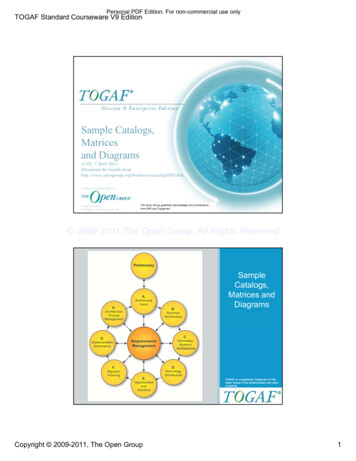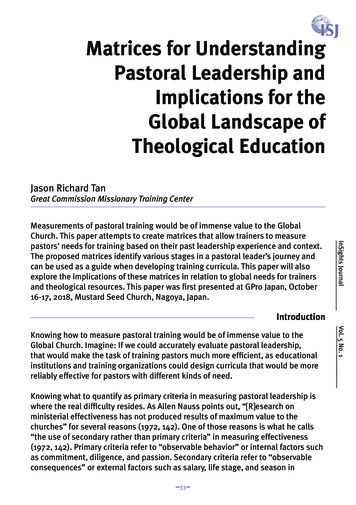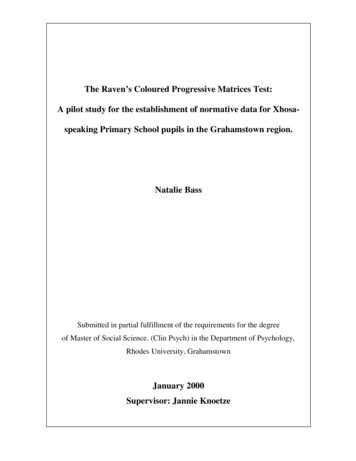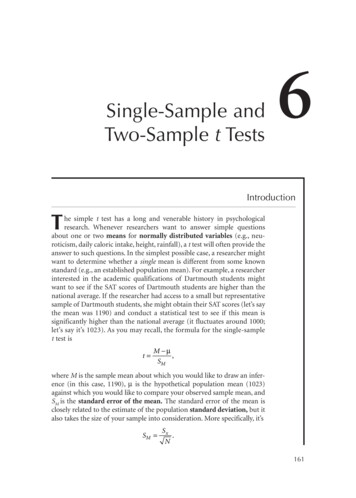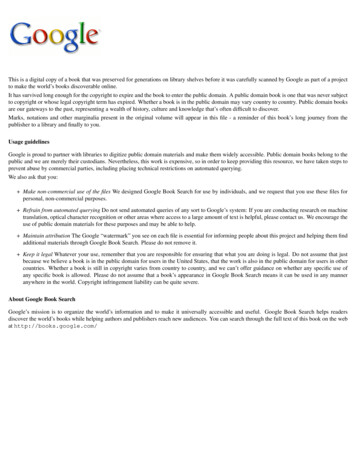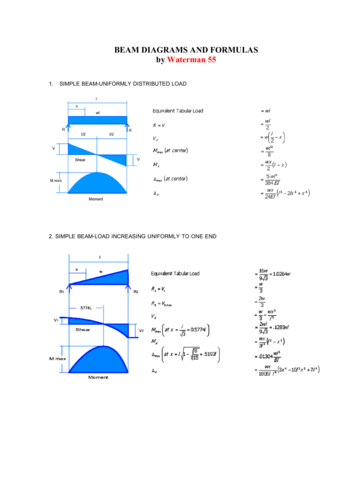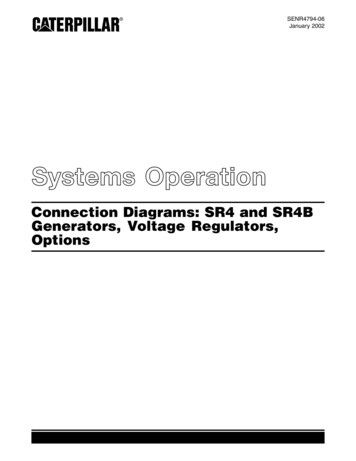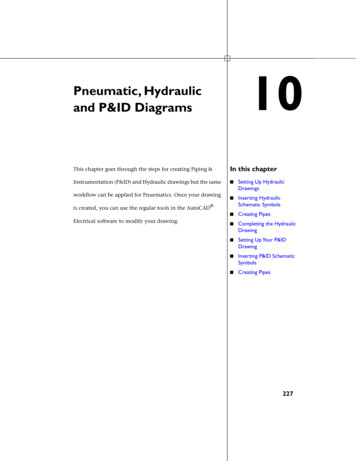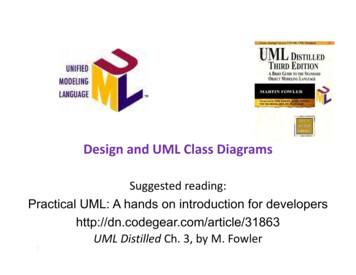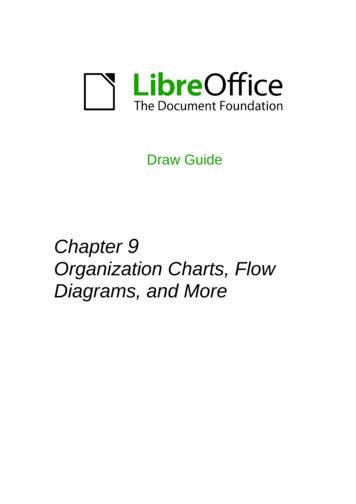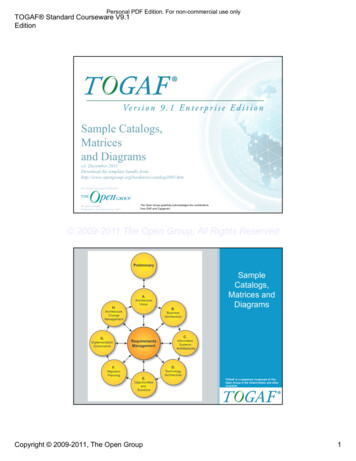
Transcription
Personal PDF Edition. For non-commercial use onlyTOGAF Standard Courseware V9.1EditionSample Catalogs,Matricesand Diagramsv3: December 2011Download the template bundle 3.htmV9.1 Edition Copyright 2009-2011All rightsSlide1 reservedPublished byOpenGroup,All2011 2009-2011TheTheOpenGroup,Rights ReservedThe Open Group gratefully acknowledges the contributionsfrom SAP and Capgemini 2009-2011 The Open Group, All Rights ReservedSampleCatalogs,Matrices andDiagramsTOGAF is a registered trademark of TheOpen Group in the United States and othercountriesSlide 2 2009-2011 The Open Group, All Rights ReservedCopyright 2009-2011, The Open Group1
Personal PDF Edition. For non-commercial use onlyTOGAF Standard Courseware V9.1EditionObjectivesThe objectives of this presentation are to illustrate: TOGAF 9 Catalogs, Matrices and Diagrams What they consist of Examples How they can be usedThe examples shown are illustrative.The exact format of the catalogs,matrices and diagrams will dependon the tools used and adaptations toTOGAF for the specific EA.Slide 3 2009-2011 The Open Group, All Rights Reserved 2009-2011 The Open Group, All Rights ReservedPreliminary Phase Principles catalogRequirements ManagementPhase A, Architecture Vision Stakeholder Map Matrix Solution Concept diagramTOGAF 9 Artifacts Phase B, Business Architecture Organization/Actor catalog Driver/Goal/Objective catalog Role catalog Business Service/Functioncatalog Location catalog Process/Event/Control/Productcatalog Contract/Measure catalog Business Interaction matrix Actor/Role matrix Business Footprint diagram Business Service/Informationdiagram Functional Decompositiondiagram Product Lifecycle diagram Goal/Objective/Service diagram Business Use-Case diagram Organization Decompositiondiagram Process Flow diagram Event diagram Value Chain diagramRequirements catalogPhase C, DataArchitecture Data Entity/DataComponent catalog Data Entity/BusinessFunction matrix Application/Datamatrix Logical Datadiagram Data Disseminationdiagram Data Securitydiagram Class Hierarchydiagram Data Migrationdiagram Data LifecyclediagramPhase E. Opportunities & Solutions Project Context diagramSlide4 Benefitsdiagram 2009-2011 The Open Group, All Rights ReservedCopyright 2009-2011, The Open GroupPhase C, ApplicationArchitecture Application Portfoliocatalog Interface catalog Application/Organizationmatrix Role/Application matrix Application/Functionmatrix Application Interactionmatrix ApplicationCommunication diagram Application and UserLocation diagram Application Use-Casediagram Enterprise Manageabilitydiagram Process/ApplicationRealization diagram Software Engineeringdiagram Application Migrationdiagram Software DistributiondiagramPhase D, TechnologyArchitecture TechnologyStandards catalog Technology Portfoliocatalog System/Technologymatrix Environments andLocations diagram PlatformDecompositiondiagram Processing diagram NetworkedComputing/Hardwarediagram CommunicationsEngineering diagramTOGAF 9 Artifacts2
Personal PDF Edition. For non-commercial use onlyTOGAF Standard Courseware V9.1EditionPhase CPreliminaryPhase –Catalogs,Matrices andDiagramsTOGAF is a registered trademark of TheOpen Group in the United States and othercountriesSlide 5 2009-2011 The Open Group, All Rights Reserved 2009-2011 The Open Group, All Rights ReservedPPreliminary PhaseCatalogs, Matrices and DiagramsCatalogs Principles CatalogDiagramsMatricesSlide 6 2009-2011 The Open Group, All Rights ReservedCopyright 2009-2011, The Open Group3
Personal PDF Edition. For non-commercial use onlyTOGAF Standard Courseware The Principles catalog captures principles of the business and architectureprinciples that describe what a "good" solution or architecture should looklike. Principles are used to evaluate and agree an outcome for architecturedecision points. Principles are also used as a tool to assist in architecturalgovernance of change initiatives.The Principles catalog contains the following metamodel entities:* PrincipleSlide 7 2009-2011 The Open Group, All Rights Reserved 2009-2011 The Open Group, All Rights ReservedPhase CPhase A:ArchitectureVision –Catalogs,Matrices andDiagramsTOGAF is a registered trademark of TheOpen Group in the United States and othercountriesSlide 8 2009-2011 The Open Group, All Rights ReservedCopyright 2009-2011, The Open Group4
Personal PDF Edition. For non-commercial use onlyTOGAF Standard Courseware V9.1EditionAArchitecture VisionCatalogs, Matrices and DiagramsCatalogsMatrices Stakeholder Map MatrixDiagrams Value Chain Diagram Solution Concept DiagramSlide 9 2009-2011 The Open Group, All Rights Reserved 2009-2011 The Open Group, All Rights ReservedStakeholder MapStakeholderKey ConcernsClassCatalogs, Matrices andDiagramsCxOThe high-level drivers, goals andobjectives of the organization, andhow these are translated into aneffective process and IT architectureto advance the businessKeepSatisfiedBusiness Footprint diagramGoal/Objective/Service diagramOrganization izing, funding, and aligningchange activity. An understanding ofproject content and technicaldependencies adds a furtherdimension of richness to portfoliomanagement and decision making.KeepSatisfiedProject Context diagramBusiness Footprint diagramApplication CommunicationdiagramFunctional DecompositiondiagramHRThe roles and Actors that support thefunctions, applications, andtechnology of the organization. HRare important stakeholders inensuring that the correct roles andactors are represented.KeepInformedOrganization DecompositiondiagramOrganization/Actor catalogLocation catalogSlide 10 2009-2011 The Open Group, All Rights ReservedCopyright 2009-2011, The Open Group5
Personal PDF Edition. For non-commercial use onlyTOGAF Standard Courseware V9.1EditionValue Chain DiagramSource: Wikipedia.orgSlide 11 2009-2011 The Open Group, All Rights Reserved 2009-2011 The Open Group, All Rights ReservedExample Value Chain DiagramsProduct& OfferSalesFulfilmentPaymentsServicingSlide 12 2009-2011 The Open Group, All Rights ReservedCopyright 2009-2011, The Open Group6
Personal PDF Edition. For non-commercial use onlyTOGAF Standard Courseware V9.1EditionExample Solution Concept Diagram A high-level representation of the solution envisaged A pencil sketch of the expected solution at the outset of t,consideration,join, re-newCustomersCertificationPublicationReliable, 24x7,self-serviceinfrastructureSlide 13 2009-2011 The Open Group, All Rights Reserved 2009-2011 The Open Group, All Rights ReservedExample Solution Concept DiagramsToday’s use of channelsTomorrow’s use of channelsHigh Value TasksRMRMSERVICETEAMFrom RMto STSERVICE TEAMFrom ServiceTeam to CCFrom RMto CCCALL CENTERCALL CENTERSELF SERVICEINTERNET PORTALFrom CallCentre toOnlineFrom ServiceTeam toOnlineFrom RMto OnlineSELF SERVICE INTERNET PORTALLow Value TasksSlide 14 2009-2011 The Open Group, All Rights ReservedCopyright 2009-2011, The Open Group7
Personal PDF Edition. For non-commercial use onlyTOGAF Standard Courseware V9.1EditionPhase CPhase B:BusinessArchitecture –Catalogs,Matrices andDiagramsTOGAF is a registered trademark of TheOpen Group in the United States and othercountriesSlide 15 2009-2011 The Open Group, All Rights Reserved 2009-2011 The Open Group, All Rights ReservedBCatalogs, Matrices and DiagramsCatalogs Organization/Actor catalog Driver/Goal/Objective catalog Role catalog Business Service/Functioncatalog Location catalog Process/Event/Control/Productcatalog Contract/Measure catalogMatrices Business Interaction matrix Actor/Role matrixDiagrams Business Footprint diagram Business Service/Informationdiagram Functional Decompositiondiagram Product Lifecycle diagram Goal/Objective/Service diagram Use-Case diagram Organization Decompositiondiagram Process Flow diagram Event diagramSlide 16 2009-2011 The Open Group, All Rights ReservedCopyright 2009-2011, The Open Group8
Personal PDF Edition. For non-commercial use onlyTOGAF Standard Courseware gPurposeA definitive listing of all participants that interact with IT, including users and ownersof IT systems.It contains the following metamodel entities: Organization Unit, Actor Location (may be included in this catalog if an independentLocation catalog is not maintained)Driver/Goal/ObjectiveCatalogA cross-organizational reference of how an organization meets its drivers in practicalterms through goals, objectives, and (optionally) measures.It contains the following metamodel entities: Organization Unit, Driver, Goal, Objective, Measure (may optionally be included)Role CatalogThe purpose of the Role catalog is to provide a listing of all authorization levels orzones within an enterprise. Frequently, application security or behavior is definedagainst locally understood concepts of authorization that create complex andunexpected consequences when combined on the user desktop.It contains the following metamodel entities: RoleSlide 17 2009-2011 The Open Group, All Rights Reserved 2009-2011 The Open Group, All Rights ReservedCatalogsCatalogPurposeBusinessService /FunctionCatalogA functional decomposition in a form that can be filtered, reported on, and queried, asa supplement to graphical Functional Decomposition diagrams.It contains the following metamodel entities: Organization Unit,Business Function, Business Service, Information System ServiceLocationCatalogA listing of all locations where an enterprise carries out business operations orhouses architecturally relevant assets, such as data centers or end-user computingequipment.It contains the following metamodel entities: LocationProcess/Event/Control/ProductCatalogThe Process/Event/Control/Product catalog provides a hierarchy of processes, eventsthat trigger processes, outputs from processes, and controls applied to the executionof processes. This catalog provides a supplement to any Process Flow diagrams thatare created and allows an enterprise to filter, report, and query across organizationsand processes to identify scope, commonality, or impact.It contains the following metamodel entities:(may optionally be included here) Process, Event, Control, ProductSlide 18 2009-2011 The Open Group, All Rights ReservedCopyright 2009-2011, The Open Group9
Personal PDF Edition. For non-commercial use onlyTOGAF Standard Courseware urposeA listing of all agreed service contracts and (optionally) the measuresattached to those contracts. It forms the master list of service levelsagreed to across the enterprise.It contains the following metamodel entities: Business Service Information System Service (optionally) Contract MeasureSlide 19 2009-2011 The Open Group, All Rights Reserved 2009-2011 The Open Group, All Rights ReservedMatrices Business Interaction matrix Actor/Role matrixSlide 20 2009-2011 The Open Group, All Rights ReservedCopyright 2009-2011, The Open Group10
Personal PDF Edition. For non-commercial use onlyTOGAF Standard Courseware V9.1EditionBusiness Interaction Matrix The purpose of this matrix is to depict the relationshipinteractions between organizations and business functionsacross the enterprise.Providing Business ServicesConsuming Business ServicesEngineering ProcurementManufacturingSales and DistributionCustomer ServiceEngineeringProcurementContract forsupply ofmaterialsManufacturingContract forsupply ofproductspecificationSales and DistributionContract for supply ofsales forecastsContract forsupply of productContract for fulfillment ofcustomer ordersCustomer ServiceSlide 21 2009-2011 The Open Group, All Rights Reserved 2009-2011 The Open Group, All Rights ReservedActor/role Matrix This matrix show which actors perform which roles,supporting definition of security and skills IIIIRCCCCRCCCCCCRRCCCCIAExternal Vendors / SuppliersIIIIIIRIIProject ManagerIIIIICRIIIIT OperationsAAAACICCIRAInfrastructure DesignerICCCIHead of ImplementationRCIIIEnterprise Infrastructure ArchitectCCIICArchitecture Configuration MgrCRIACInfrastructure nfrastructure Solution ArchitectAAIRCICCStrategy and ArchitectureActorsHead of Strategy and ArchitectureBusiness Unit Service OwnerBusiness Unit Application ArchitectBusiness Unit HeadEnterprise ArchitectIT Management ForumIBusiness UnitActorsTechnical Design AuthorityIIISteering GroupActorsEnterprise Design AuthorityR Responsible for carrying out the roleA Accountable for actors carrying out the roleC Consulted in carrying out the roleI Informed in carrying out the roleStrategy Lifecycle RolesArchitecture RefreshArchitecture RoadmapBenefits AssessmentChange ManagementFramework RefreshProject Lifecycle RolesSolution Architecture VisionLogical Solution ArchitecturePhysical Solution ArchitectureDesign GovernanceArchitecture Configuration ManagementCIOOffice ofCIO ActorsCCIRRRCASlide 22 2009-2011 The Open Group, All Rights ReservedCopyright 2009-2011, The Open Group11
Personal PDF Edition. For non-commercial use onlyTOGAF Standard Courseware V9.1EditionDiagrams Business Footprint diagramBusiness Service/Information diagramFunctional Decomposition diagramProduct Lifecycle diagramGoal/Objective/Service diagramUse-Case diagramOrganization Decomposition diagramProcess Flow diagramEvent diagramSlide 23 2009-2011 The Open Group, All Rights Reserved 2009-2011 The Open Group, All Rights ReservedBusiness Footprint Diagram Describes the links between business goals, organizationalunits, business functions, and services, and maps thesefunctions to the technical components delivering therequired capability. Demonstrates only the key facts linking organization unitfun
diagram Functional Decomposition diagram Product Lifecycle diagram Goal/Objective/Service diagram Business Use-Case diagram Organization Decomposition diagram Process Flow diagram Event diagram TOGAF 9 Artifacts Stakeholder Map Matrix Solution Concept diagram Value Chain diagram Requirements catalog
